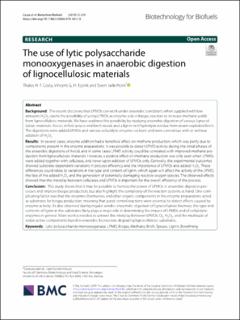| dc.contributor.author | Costa, Thales HF | |
| dc.contributor.author | Eijsink, Vincent | |
| dc.contributor.author | Horn, Svein Jarle | |
| dc.date.accessioned | 2020-03-06T12:49:54Z | |
| dc.date.available | 2020-03-06T12:49:54Z | |
| dc.date.created | 2019-11-30T14:40:56Z | |
| dc.date.issued | 2019 | |
| dc.identifier.issn | 1754-6834 | |
| dc.identifier.uri | https://hdl.handle.net/11250/2645824 | |
| dc.description.abstract | Background The recent discovery that LPMOs can work under anaerobic conditions when supplied with low amounts H2O2 opens the possibility of using LPMOs as enzyme aids in biogas reactors to increase methane yields from lignocellulosic materials. We have explored this possibility by studying anaerobic digestion of various lignocellulosic materials: Avicel, milled spruce and birch wood, and a lignin-rich hydrolysis residue from steam-exploded birch. The digestions were added LPMOs and various cellulolytic enzyme cocktails and were carried out with or without addition of H2O2. Results In several cases, enzyme addition had a beneficial effect on methane production, which was partly due to components present in the enzyme preparations. It was possible to detect LPMO activity during the initial phases of the anaerobic digestions of Avicel, and in some cases LPMO activity could be correlated with improved methane production from lignocellulosic materials. However, a positive effect on methane production was only seen when LPMOs were added together with cellulases, and never upon addition of LPMOs only. Generally, the experimental outcomes showed substrate-dependent variations in process efficiency and the importance of LPMOs and added H2O2. These differences could relate to variations in the type and content of lignin, which again will affect the activity of the LPMO, the fate of the added H2O2 and the generation of potentially damaging reactive-oxygen species. The observed effects showed that the interplay between cellulases and LPMOs is important for the overall efficiency of the process. Conclusion This study shows that it may be possible to harness the power of LPMOs in anaerobic digestion processes and improve biogas production, but also highlight the complexity of the reaction systems at hand. One complicating factor was that the enzymes themselves and other organic components in the enzyme preparations acted as substrates for biogas production, meaning that good control reactions were essential to detect effects caused by enzyme activity. As also observed during regular aerobic enzymatic digestion of lignocellulosic biomass, the type and contents of lignin in the substrates likely plays a major role in determining the impact of LPMOs and of cellulolytic enzymes in general. More work is needed to unravel the interplay between LPMOs, O2, H2O2, and the multitude of redox-active components found in anaerobic bioreactors degrading lignocellulosic substrates. | |
| dc.language.iso | eng | |
| dc.relation.uri | https://biotechnologyforbiofuels.biomedcentral.com/articles/10.1186/s13068-019-1611-8 | |
| dc.title | The use of lytic polysaccharide monooxygenases in anaerobic digestion of lignocellulosic materials | |
| dc.type | Peer reviewed | |
| dc.type | Journal article | |
| dc.description.version | publishedVersion | |
| dc.source.volume | 12 | |
| dc.source.journal | Biotechnology for Biofuels | |
| dc.source.issue | 1 | |
| dc.identifier.doi | 10.1186/s13068-019-1611-8 | |
| dc.identifier.cristin | 1754932 | |
| dc.relation.project | Norges forskningsråd: 270038 | |
| dc.relation.project | Norges forskningsråd: 257622 | |
| dc.relation.project | Norges forskningsråd: 243950 | |
| cristin.unitcode | 192,12,0,0 | |
| cristin.unitname | Kjemi, bioteknologi og matvitenskap | |
| cristin.ispublished | true | |
| cristin.fulltext | original | |
| cristin.qualitycode | 1 | |
